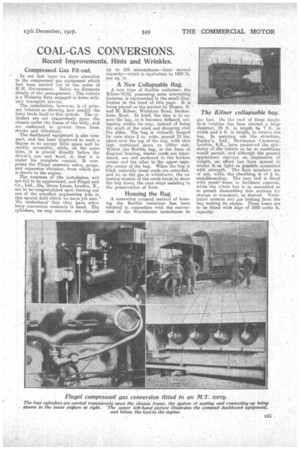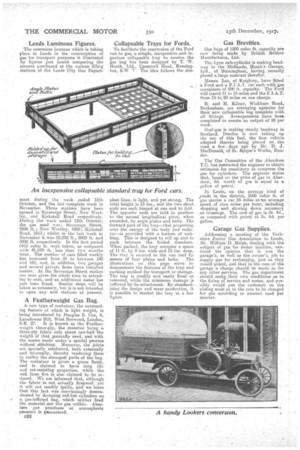COAL-GAS CONVERSIONS.
Page 19

Page 20

If you've noticed an error in this article please click here to report it so we can fix it.
Recent Improvements, Hints and Wrinkles.
Compressed Gas Fit-out.
In our last issue we drew attention to the compressed gas equipment which had been carried out to the order of H.M. Government. 13elow we illustrate details of the arrangement. The vehicle is a Wolseley ferry engaged in home military transport service.
The installation, however; is of primary interest as showing how ,readily the lorry lends itself to this system. The cylinders are set transversely upon the chassis under the frame of the body, and are cushioned to protect them from shocks and vibrations.
The dashboard equipment is also compact, and has been improved to such a degree as to occupy little space and be readily accessible, while, at the same time, it is placed directly before the driver's eye and hand, so that it is under his coniplete control. It comprises the Flugel pressure valve, gauge, and expansion chamber, from which gas is drawn to the engine. The neatness of the installation will not fail to be appreciated, and Flugel and Co., Ltd., 33a, Green Lanes, London, N., are to be congratulated upon turning out one of the soundest engineering jobs in this special field which we have yet seen.' We understand that they have other lorry conversion contracts in hand. The cylinders, we may mention, are charged up to 125 atmospheres—their normal Capacity—which is equivalent to 1800 lb. per sq. in.
A New Collapsable Bag.
A new type of flexible container, the Kilner-Wild, possessing some interesting features, is represented in the small illustration at the head of this page. It is being-placed on the market by Messrs. R. and IL Liner, Wickham Road; Beckenham, Kent. In brief, the idea is to ensure the bag, as it becomes deflated, col-lapsing within its tray, instead of being the sport, of the wind and drooping over the sides. The-bag is virtually hooped by cane stays in. wide, spaced 12 ins. apart over the top of the bag, with thin legs, continued down on either side. Within the flexible bag, in the form of diagonal bracing, elastic cords are introduced, one end anchored to the bottom corner and the other to the upper opposite corner of the bag. When the' bag is filled, naturally these cords are extended, and so; as the gas is withdrawn, the releasing-tension of the cords tends to draw the bag down, the cane stays assisting in the preservation of form.
Housing the Bag.
A somewhat unusual method of housing the flexible 'container has, been adopted in connection with the converBien of the Warminster motorbm_ses to
The Kilner collapsable bag.
gas fuel. On the roof of these singledeck -vehicles has been erected a large chamber, 24 ft. in length by 7 it. in • width and 5 ft. in height, to receive the bag. In carrying out the structure, Bayley's, Ltd., Newington Causeway,. London, S.E., have preserved the syrn&try of the vehicle so far as conditions would permit, and although the general appearance conveys an impression of weight, no effort has been spared to render it as light as possible consistent with strength. The floor members are of ash, while the sheathing is of in. matchboarding. The rear end is fitted with paner-doors tc facilitate removal, while the whole box is so assembled as to permit dissembling into sections for storage or transport, as desired. Ventilation ensures any. gas leaking from the bag making its escape. These buses are to be fitted with bags of 1000 cubic ft. capacity.
Leeds Luminous Figures.
The enormous increase which is taking place in Leeds in the consumption of gas for transport purposes is illustrated by figures just issued comparing the amount purchased at the various filling stations of the Leeds City Gas Depart merit during the week ended 12th October, and the last .complete week in November. Three stations have been opened in Sovereign Street, New _Wortley, and Kirkstall Road respectively. During the week ended 12th October, the gas used was : Sovereign Street, 2900 ft. ; -New Wortley, 1900; Kirkstall Road, 1615; -whilst in the last `Week in November it was 28,878 ft., 8000 ft. and 5000 ft. respectively. In the first period 6415 cubic ft. were taken, as compared with 41,878 ft. less than two months later. The number of cars filled weekly has increased from 35 to between 140 and 160, and, in addition, two garages and several private firms have installed meters. At the Sovereign Street station one Man gives his whole time to attending-to cars, and an additional meter has just been fitted. Similar steps will be taken as necessary, but it is not intended to open any new stations at present.
A Featherweight Gas Bag.
A new type of container, the outstanding feature of which is light weight, is being introduced -by Douglas S. Cox, 6, Lansdowne Hill, West Norwood, London, S.E. 27. It is known as the Featherweight three-ply, the material being a three-ply fabric only about one-half the weight-of that generally used and with. the seams made under a special process without stitching. Moreover, the joints are specially reinforced, both externally and internally, thereby rendering them in reality the strongest parts of. the bag. The container is given a green finish, and is claimed to have long life ad rot-resisting properties, while the risk from fire is also claimed to be reduced: We are informed that, although the fabric-is not actually fireproof, yet it will not readily ignife, and we learn that this fact was convincingly demonstrated by dropping red-hot cYlinders on
gas-inflated bag, which neither fired the material.nor the gas within. Absolute gas proofness at atmospheric pressure is guaranteed.
052
Collapsable Trays for Fords.
To facilitate the conversion of the Ford van to gas, a simple, inexpensive and ingenious collapsable tray to receive the gas bag has been designed by T. W. Heath, Ltd., Cromwell Road, Kensington, S.W 7 The. idea follows the elm
pleat lines, is light, and yet strong. The total height is 13 ins., and the two short ends are each hinged at one end to fold. The opposite ends are held in position to the second longitudinal piece, when extended, by angle plates and bolts. The forward part of the tray—that projecting over the canopy of the body and radiator—is provided with a bottom of webbing. This is designed to roll up and to pack between the folded members. When packed, the tray occupies a space of 11 ft. by 9 ins, wide and 13 ins. deep, The tray is secured to the van roof by means of four plates and bolls. The illustrations on this page servo to demonstrate the features of the tray and packing method for transport or storage. The tray is readily and easily fixed or removed, while the minimum damage is inflicted by its attachment. By standardizing the design and mass production, it is possible to market the tray at a low figure.
Gas Brevities.
Gas hags of 1500 cubic ft. capacity are DOW being made by British Rubber Manufactures, Ltd.
The Lyon safe-cylinder is making headway in the .Midlands, Heath's Garage, Ltd., of Birmingham, having recently placed a large contract therefor.
Messrs. Lee, of Keighiey, have fitted a Ford and a F.I.A.T. car each with gas containers of 200 ft. capacity. The Ford will travel 11 to 15 miles and the from 15 to 20 miles on one charge.. .
R. and H. Kilner, Wickham 'Road, Beckenham, are arranging agencies for their new collapsable bag complete with all fittings. Arrangements have been completed to ensure an output of 50 per week.
Goal-gas is making steady headway in Scotland. Dundee is now taking up the use of this fuel, the first vehicle adapted thereto being placed on the road a few days ago by Mr. D. J. MacDonald, of St. Roque's Works, Dundee.
The Gas Committee of the Aberdeen T.O. has instructed the engineer to obtain estimates for machinery to compress the gas for cylinders. The engineer states that, -based on the price of gas in Aberdeen, 9d worth of gas is equal to a
gallon of petrol. • In Leeds, on the average kind of ;pads in the district, 1000 cubic ft. of gas carries a car 25 miles atm.ri average speed of nine miles per hour, including stopping and slowing down necessary at crossings. The cost of gas is 3s4d., as compared with petrol at Sc. 6d. per gallon.
Garage Gas Supplies. •
Addressing a meeting of the Yorkshire Junior Gas Association in Leeds, Mr. William D. Helps, dealing with the subject of gas for Motor traction, ventured his opinion that it was • the garage's, as -well as the owner's, job to supply gas for recharging, just as they would petrol, and that in the case of the garage a charge should 'be made as for any other services. The gas department should make_. their own conditions as to the fixing of service and meter, andpossibly would put the customer on the sliding scale as to the rate to be charged for gas according to amount used per quarter.


























